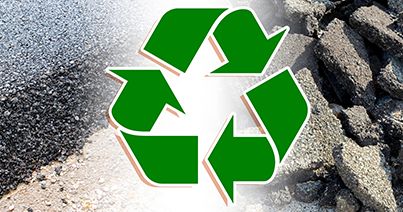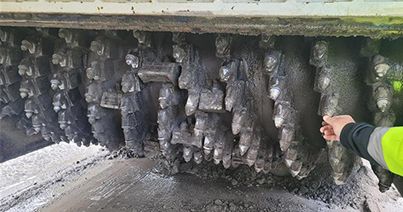Revolutionizing Road Construction: Embracing Renewable Materials

Social awareness and sustainability for the environment have been driving change in businesses across many industries. As companies seek to protect the environment, they have been integrating Environmental, Social, and Governance (ESG) practices to secure an eco-friendlier future. Road construction is one of those industries undergoing a significant transformation, where the adoption of ESG and renewable materials plays a pivotal role in the environment.
What is Environmental, Social, and Governance?
Environmental, Social, and Governance (ESG) is made up of three pillars, which represent best practices to help companies assess and communicate their impact on sustainability, ethical business decisions, and corporate responsibility.
The Pillars:
- Environmental focuses on energy usage and efficiency, waste management, greenhouse emissions, and minimizing carbon footprint.
- Social addresses a company's relationships with its employees, equal employment opportunities, labor laws and health and safety practices, and community engagement.
- Governance refers to the company's internal policies, corporate governance, compliance, regulatory standards, ethical business practices, and transparency.
It Begins with the Foundation
Ensuring a proper foundation is essential to the success and longevity of the rehabilitated road. The foundation serves as the base layer that supports the entire road structure and distributes the weight of traffic, vehicles, and other environmental factors such as rain, heat or snow.
Key Considerations before road rehabilitation include:
- Assessing existing foundation and searching for potential weaknesses or deficiencies in the foundation layer.
- Understanding the natural soil layer beneath the road surface to prevent settlement or structural fractures.
- Fixing and reinforcing underlying foundation issues and implementing appropriate measures
- Monitoring compaction levels, conducting density tests, and verifying the integrity of base layers

Using Renewable Materials in Road Construction
Using renewable materials in road construction can significantly reduce the negative impact on the environment. Asphalt mixes, for example, can be made from recycled tires or roads constructed from biodegradable materials can be an eco-friendly alternative to conventional materials. This not only decreases the demand for new resources but also minimizes the carbon footprint.
Both asphalt and biodegradable mixes can improve road flexibility, reduce cracking, provide better skid resistance, and reduce noise levels. Additionally, incorporating recycled materials into road construction projects can divert materials from landfills and reduce the need for extracting new raw materials.
Asphalt Mixes from Recycled Tires:
- Road construction projects that implement asphalt mixes made from recycled tires can improve durability, increase long-term performance, and reduce cost as compared to traditional asphalt.
Biodegradable Road Construction Materials:
- Biodegradable materials used in road rehabilitation conserve natural resources, reduce damage to soil and water quality, and promote long-term sustainability. They also use eco-friendly binders such as bio-based mulches, polymers, and geotextiles.
The Pros and Cons of ESG
While there are challenges associated with embracing renewable materials and ESG practices, the benefits often outweigh the drawbacks. Companies that successfully navigate these challenges can reap significant rewards in terms of sustainability, reputation, and long-term financial performance.
The Pros
- Renewable materials are replenished naturally over time, reducing the strain on finite resources, and promoting long-term sustainability.
- Both renewable materials and ESG practices aim to minimize environmental harm -- leading to a significant reduction in a carbon footprint.
- Those who prioritize renewable materials and ESG practices can enhance their brand reputation among consumers, employees, and the public.
- ESG practices can help you stay ahead of regulatory changes and avoid potential fines and penalties.
- Embracing renewable materials often requires innovation in product design, manufacturing processes, and supply chain management. This can lead to new opportunities for growth and differentiation in the market, providing a competitive advantage.
The Cons
- The initial costs of transitioning to renewable materials and implementing ESG practices can be high. However, these costs often pay off in the long run through operational efficiencies and market opportunities.
- ESG metrics can be complex to define and measure accurately. The lack of standardized ESG performance across companies and industries can be a challenge.
- Sourcing renewable materials can present logistical challenges and require supply chain management changes.
- Some renewable materials may not offer the same performance as their non-renewable counterparts.
- ESG practices require a holistic approach that can be complex to implement and involve changes at multiple levels of an organization.
While there are both benefits and limitations to ESG practices and the use of renewable materials, it's essential for companies to strike a balance that considers both environmental and social responsibilities.

Road Rehab Pick Design
Road Rehabilitation (RR) picks can improve the size or quality of milled pavement particles for re-use. It's important to consider the characteristics of the particles and their impact on the overall reusability and performance of the recycled material. Both larger and smaller chunks have their advantages and limitations, and the choice between them depends on various factors related to the recycling process and the intended application of the recycled material.
Larger Materials
- Larger pieces milled pavement can be easier to handle during the recycling process. They are less likely to become airborne or create dust compared to fine particles, which can improve safety and environmental conditions at the recycling site.
- The large particles may require less processing or crushing compared to finer particles and lead to cost savings in terms of energy consumption and equipment maintenance.
- In some cases, larger materials can contribute to better structural stability in the recycled pavement layer. They may provide a stronger interlock and resistance to deformation, enhancing the overall durability of the rehabilitated road.
Smaller Materials
- Smaller particles have a higher surface area-to-volume ratio, which facilitates better mixing with binding agents such as asphalt emulsions which can result in improved bonding between recycled materials and fresh asphalt layers.
- Finer particles can fill voids more effectively during compaction, leading to improved density and resistance to moisture infiltration in the recycled pavement.
- The smaller materials can be used in a wide range of applications, including surface treatments, patching, and base layers, offering flexibility.
Achieving the desired balance between larger and smaller material in milled pavement recycling involves an approach that considers technical, economic, and environmental factors.
How Kennametal Can Help?
Road rehabilitation takes your tooling equipment through rough conditions. Kennametal cutting tools are designed for long tool life, excellent holder protection, and smooth machine operation – enabling you to run longer and be more productive.
Some of our tooling solutions for road milling equipment includes:
- Road King Diamond Flex which can be used for asphalt and larger highway projects
- Road Planers with KenCast™ wear protection for removing asphalt and concrete surfaces
These solutions, along with our expertise, will be able to reduce downtime, and change parts efficiently reducing waste.
Larger Materials
- Larger pieces milled pavement can be easier to handle during the recycling process. They are less likely to become airborne or create dust compared to fine particles, which can improve safety and environmental conditions at the recycling site.
- The large particles may require less processing or crushing compared to finer particles and lead to cost savings in terms of energy consumption and equipment maintenance.
- In some cases, larger materials can contribute to better structural stability in the recycled pavement layer. They may provide a stronger interlock and resistance to deformation, enhancing the overall durability of the rehabilitated road.
Summary
Road rehabilitation provides an important link between connecting people and facilitating the movement of commerce for a better quality of life. By incorporating an ESG strategy with renewable materials, sustainable sourcing, and energy-efficient technologies, we can overcome harmful environmental challenges and build a greener future.
For additional information on finding the most effective road rehabilitation equipment to fit your needs, contact our Kennametal experts.
Related Articles
- Safety Tips in Road Rehabilitation Projects Road rehabilitation is essential for maintaining and improving our transportation infrastructure. Discover key safety tips and best practices to ensure successful and secure projects.Road rehabilitation is essential for maintaining and improving our transportation infrastructure. Discover key safety tips and best practices to ensure successful and secure projects.
- Revolutionizing Road Construction: Embracing Renewable MaterialsBy incorporating an ESG strategy in road rehabilitation we can overcome harmful environmental challenges and build a greener future. Learn more from Kennametal.By incorporating an ESG strategy in road rehabilitation we can overcome harmful environmental challenges and build a greener future. Learn more from Kennametal.
- Expert Tips for Off-Season Milling Drum Maintenance Peak performance, longevity, and more… Explore several tactics you should use in the off-season to make sure your milling drums are ready for every season.Peak performance, longevity, and more… Explore several tactics you should use in the off-season to make sure your milling drums are ready for every season.
- Proven Solution: Grinding Concrete with RK4-01Bring greater productivity to the grind by requiring fewer change-outs of cutting tools on your machine Learn how with Kennametal's Road King cutting tools.Bring greater productivity to the grind by requiring fewer change-outs of cutting tools on your machine Learn how with Kennametal's Road King cutting tools.



